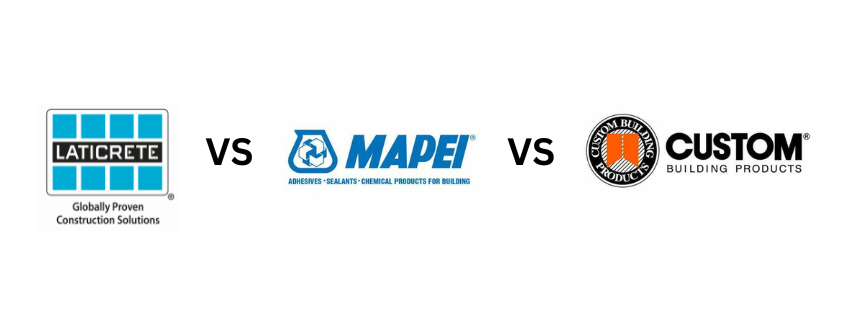Sustainability of Three Grout Companies
How sustainable are different grout types? What grout manufacturers are going above and beyond to make their products more sustainable? Let’s answer that question as we compare Laticrete, Mapei, and Custom Building Products!
Let’s look at environmental and social sustainability. Environmental sustainability considers greenhouse gas emissions, natural resources, and biodiversity. Social sustainability considers impacts to human health for people involved in manufacturing, people involved in installation, or people living in the spaces with a material. Social sustainability also deals with topics such as living wages and safe working conditions.
In building materials, the two largest sustainability documentation programs are Environmental Product Declarations (EPDs) and Health Product Declarations (HPDs). These documents help consumers determine the scale of environmental impacts or health concerns and can be compared across products. In an ideal world, these documents are easily available to the public on a product’s webpage, without the need to contact a company representative. When corporations publish information about the possible health and environmental impacts of their products, consumers can use that information to make better decisions.
There are a few external websites that publish information on what certifications products have. The Origin website is easy to browse, and allows you to search products and see if they have EPDs, HPDs, and other product certifications. As a bonus, it also indicates whether or not any documentation is expired. The website does not store the EPD/HPD documents, so you’ll have to do more digging if you want to download them. https://origin.build/#/materials?p=P&locale=en
All HPDs are available on the Health Product Declaration Repository. https://hpdrepository.hpd-collaborative.org/Pages/Results.aspx Having everything in one place and easily searchable makes it easy to find products that have this documentation.
Now, back to our question about the sustainability of grout manufacturers. I looked at three large grout manufacturers: Laticrete, Mapei, and Custom Building Products. This is what I found.
Laticrete
Environmental Sustainability
EPDs
They have EPDs available for download on their website, but they are all industry-wide EPDs for grout made in North America (published by the TCNA - Tile Council of North America). If the EPDs were specific to Laticrete’s products, this would show a greater commitment from Laticrete and actually allow consumers to compare different grout manufacturers. https://www.laticrete.com/en/document-library#filterdocuments_e=0&filterdocuments_documenttypes=Approvals%20and%20Certifications&filterdocuments_leedtype=EPD
There is no EPD available for their epoxy grout
Recycled content
Laticrete notes that most of their products do not contain any post-consumer or pre-consumer recycled content.
Manufacturing Location
Laticrete states: “Most LATICRETE portland cement and sand based products are manufactured at our local facilities. Many of the raw materials used to manufacture these products supplied are sourced from within a 100 mile (162 km) radius” (source: https://cdn-global.laticrete.com/-/media/project/laticrete-international/shared/files/support-and-downloads/technical-datasheets/tds251.ashx?la=en)
Latricrete lists their locations as: Bethany (CT), Corona (CA), Grand Prairie (TX), West Palm Beach (FL), Indianapolis (IN), Hamlet (NC), Lebanon (OR), Pottstown (PA).VOCs
Cementitious Grouts
Permacolor, Permacolor Select, Permacolor Select NS: 0.00 g/L
Epoxy Grouts:
Spectralock Dazzle: 0.00 g/L
Spectralock Pro: 0.031 g/L
Spectralock Pro Premium Translucent Grout: 59 g/L
Spectralock 2000 IG: 0.80 g/L
Social Sustainability
HPDs
HPDs are available for Permacolor, Permacolor Select, Spectralock, and Ready-to-Use
Respirable Crystalline Silica
Permacolor, Permacolor Select and Spectralock grouts have respirable crystalline silica, but they are certified by an independent laboratory to be below the OSHA action levels. https://www.laticrete.com/en/about-us/innovation-and-impact/osha-silica
Mapei
Environmental Sustainability
EPDs
Their website notes that they have EPDs for many products - you can find them on their individual product pages. Some EPDs are only the industry-wide EPDs.
Ultracolor Plus FA (6.19E-01 kg CO2eq)
Keracolor (industry-wide EPD)
Kerapoxy (no EPD)
Manufacturing Locations
Their grout product pages do not list extraction or manufacturing locations, but they say that you can reach out to them to find out manufacturing locations.
Other Sustainable Attributes
They have product ‘Sustainability Reports’ for each grout, which show each grout’s sustainability certifications.
They do have some grout products for which they offset any carbon impacts by purchasing carbon offsets. This includes Ultracolor Plus FA
Social Sustainability
There was no information on HPDs on their website, but the HPD repository has HPDs for the following grout products:
Ultracolor Plus FA (expired)
Flexcolor CQ (expired)
Respirable Crystalline Silica
MAPEI notes that they “have conducted the independent, third-party testing that is required to know that our employees’ work environments are below the thresholds.” Source: https://www.mapei.com/us/en-us/training-and-technical-service/tech-talk-blog/detail/mapei-blog/2017/10/12/cement-based-products-and-osha-thresholds-for-respirable-crystalline-silica
Custom Building Products
Environmental Sustainability
EPDs
They don’t have EPDs for their specific products; rather, they have the industry-wide EPD for cementitious grout made in North America (published by the TCNA - Tile Council of North America).
Recycled content
I have not been able to find any of their grouts with recycled content.
Manufacturing Location
I have not been able to find any information on manufacturing or extraction locations.
Social Sustainability
HPDs
The HPD repository has HPDs for the following grout products:
Polyblend Sanded/Nonsanded (and Plus)
Simple Grout Premixed
Respirable Crystalline Silica
Custom Building Products has a statement on respirable crystalline silica that implies that its products meet the requirements, but it is a little unclear on actual tested values.
Discussion
Latricrete and Mapei both offered more sustainability information than Custom Building Products. Laticrete had the most information (VOC comparisons, manufacturing and recycled content info), while Mapei offered one product that they promote as “carbon neutral”. None of the companies had EPDs for epoxy grout, and only Mapei had product-specific EPDs .
All companies appeared to comply with OSHA regulations on respirable silica and all companies had at least two grout HPDs. However, Laticrete had the most HPDs.
If I were to choose a grout manufacturer based on the sustainability info I found, I would choose Mapei or Laticrete, as they are more transparent with their sustainability information than Custom Building Products.
Let me know if there are other grout companies that I should look into, or if there is important sustainability info that I should add to this post!

